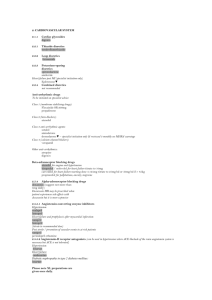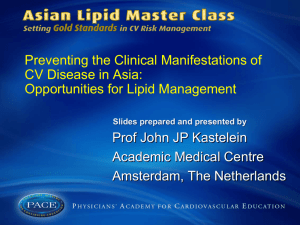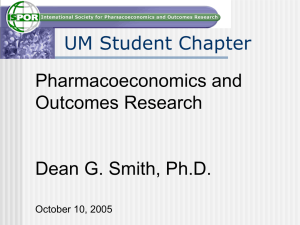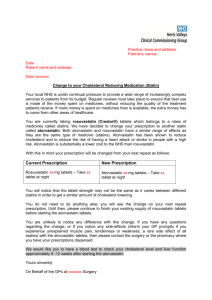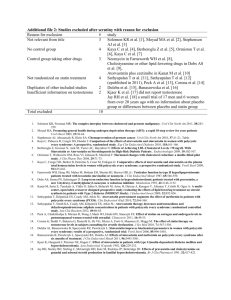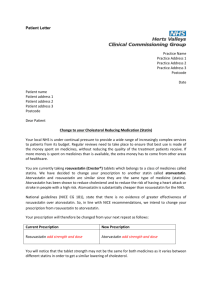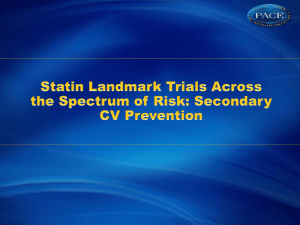ideal-rc - Clinical Trial Results
advertisement
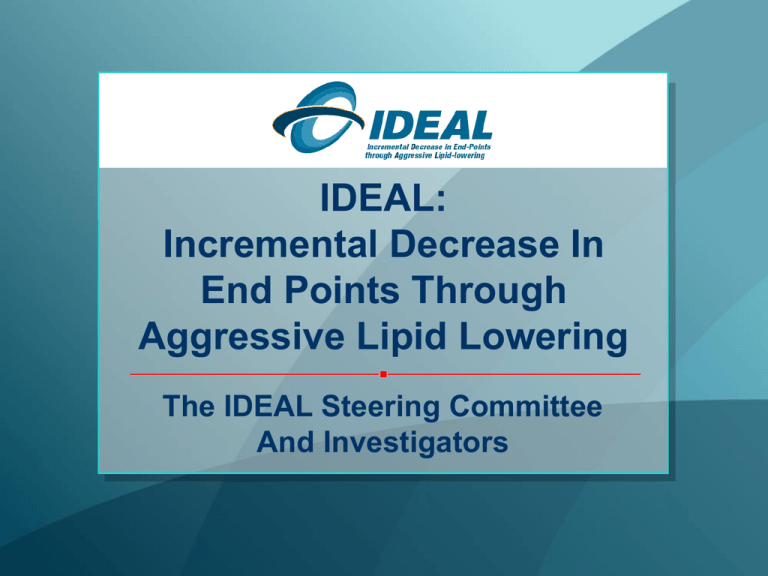
IDEAL: Incremental Decrease In End Points Through Aggressive Lipid Lowering The IDEAL Steering Committee And Investigators Background CVD: A Major Global Health Issue • CHD and stroke are two major components of CVD • 16.7 million worldwide die each year from CVD • CVD affects 34.2% of US population • Elevated plasma lipids are one of the most prevalent risk factors for CVD American Heart Association. Heart Disease and Stroke Statistics - 2005 Update. Available at: http://www.americanheart.org/downloadable/heart/1105390918119HDSStats2005Update.pdf. Accessed 11/9/05. World Health Organization. The Atlas of Heart Disease and Stroke. Available at: http://www.who.int/cardiovascular_diseases/resources/atlas/en/. Accessed 11/3/05. 2 Although CVD-Related Deaths Remain High, the CVD-Related Death Rate Is Decreasing US 1979-2002 600 1000 500 800 400 600 300 400 200 200 100 0 1979 1980 1981 1982 1983 1984 1985 1986 1987 1988 1989 1990 1991 1992 1993 1994 1995 1996 1997 1998 1999 2000 2001 2002 Annual CVD Deaths x1000 (bar) 1st Statin Introduced Year NCEP ATP II NCEP ATP I There are nearly 1 million CVD-related deaths each year 0 CVD Deaths/100,000 Population (line) 1200 NCEP ATP III Adapted from National Institutes of Health. Morbidity & Mortality: 2004 Chart Book on Cardiovascular, Lung, and Blood Diseases. Available at: http://www.nhlbi.nih.gov/resources/docs/04_chtbk.pdf. Accessed 11/9/05; Mevacor approval history. Available at: http://www.accessdata.fda.gov/scripts/cder/drugsatfda. Accessed December 8, 2005; Expert Panel. Arch Intern Med. 1988;148:36–69; Expert Panel. JAMA. 1993;269:3015–3023; Expert Panel. JAMA. 2001;285:2486-2497. 3 Global Economic Impact of CVD Global • CVD = leading cause of mortality and disability European Union • Costs = €168.9 billion for CVD in 2003, of which €45.0 billion was for treating CHD United States • CVD = single greatest economic burden on health care system • Costs = $393.5 billion for CVD in 2005 – Total costs for all cancers = $190 billion in 2004 American Heart Association. Heart Disease and Stroke Statistics - 2005 Update. Available at: http://www.americanheart.org/downloadable/heart/1105390918119HDSStats2005Update.pdf. Accessed 11/9/05; British Heart Foundation. Total Costs of CVD in Europe. Available at: http://www.heartstats.org/topic.asp?id=4545. Accessed 11/3/05; Bonow RO et al. Circulation. 2002;106:1602-1605. 4 Elevated Cholesterol Levels Associated With High Risk of CHD 18 16 14 12 10 8 6 4 2 0 140 160 180 200 220 240 260 280 300 320 Framingham Study (N=5209) 6-Year CHD Incidence Per 1000 Men Age-Adjusted 6-Year CHD Mortality Per 1000 Men Multiple Risk Factor Intervention Trial (MRFIT) (N=361,662) 150 125 100 75 50 25 0 204 205-234 235-264 265-294 Total Cholesterol (mg/dL) Each 1% Reduction in Total Cholesterol Level Resulted in a 2% Decrease in CHD Risk 295 Total Cholesterol (mg/dL) Each 1% Increase in Total Cholesterol Level Associated With a 2% Increase in CHD Risk Adapted from Martin MJ et al. Lancet. 1986;2:933-936, with permission. Reproduced from Castelli WP. Am J Med. 1984;76:4-12, with permission. 5 Evolution of Guidelines Driven By Clinical Evidence First Joint European 1994 NCEP ATP I 1988 1980s Early Data Framingham 1981 Atherosclerosis Study Group 1984 LRC-CPPT 1984 MRFIT 1986 Coronary Drug Project 1986 Helsinki Heart Study 1987 Second Joint European 1998 NCEP ATP II 1994 1990s Angiographic Trials CLAS 1987 FATS 1990 POSCH 1990 Lifestyle Heart Trial 1990 STARS 1992 Meta-Analyses NCEP ATP III 2001 Third Joint European 2003 NCEP Report 2004 2000s Outcomes Trials 4S 1994 WOSCOPS 1995 CARE 1996 LIPID 1998 AFCAPS/TexCAPS 1998 VA-HIT 1999 Recent Data TNT 2005 IDEAL 2005 HPS 2002 ALLHAT 2002 PROSPER 2002 ASCOT-LLA 2003 PROVE IT 2004 CARDS 2004 Holme 1990 Rossouw 1991 6 Current Lipid Treatment Guidelines The Primary Focus of Treatment Guidelines Is to Reduce LDL-C NCEP Guidelines • Low risk: LDL-C <160 mg/dL • Moderate risk: LDL-C <130 mg/dL for individuals with 2 risk factors • High risk: LDL-C <100 mg/dL for individuals with CHD or CHD equivalents • Very high risk (optional): LDL-C <70 mg/dL for high-risk individuals (eg, those with CHD and diabetes) European Guidelines • LDL-C <100 mg/dL for at-risk individuals • <100 mg/dL for high-risk individuals (eg, those with diabetes) • Triglycerides: secondary target for lowering • HDL-C: secondary target for raising Expert Panel. JAMA. 2001;285:2486-2497; Grundy SM et al. Circulation. 2004;110:227-239; De Backer G et al. Eur Heart J. 2003;24:1601-1610. 7 4S to IDEAL 11 Years of Landmark Statin Trials 1994 4S 1995 WOSCOPS 1996 CARE 1998 AFCAPS/TexCAPS LIPID 2001 2002 MIRACL HPS PROSPER ALL-HAT LLT ASCOT-LLA PROVE IT ALLIANCE CARDS A to Z 2003 2004 2005 TNT IDEAL Early Trials Proved Relative Risk Reduction in Morbidity and Mortality vs Placebo Second Wave of Trials • Focus on other high-risk groups – ACS, elderly, DM, HTN • Comparisons beyond placebo – vs usual care (ALLIANCE, ALL-HAT) – active comparator (PROVE IT, A to Z) Intensity of Statin Treatment in Stable CHD Patients Receiving Contemporary Therapy 8 4S Proved 2º Prevention With Statins Could Lower Mortality and CV Events Primary End Point: Total Mortality Secondary End Point: Major Coronary Events* 1.00 Proportion Alive Simvastatin 0.95 30% RRR 0.90 Placebo P=.0003 0.85 0.80 0 1 2 3 4 5 6 Years Since Randomization Proportion Without Major Coronary Event 1.00 Simvastatin 0.90 0.80 34% RRR Placebo 0.70 P=.00001 0.60 0.50 0 1 2 3 4 5 6 Years Since Randomization * Defined as coronary death, nonfatal definite or probable MI, silent MI, or resuscitated cardiac arrest. Reproduced from Scandinavian Simvastatin Survival Study Group. Lancet. 1994;344:1383-1389, with permission. 9 4S Left Important Questions To Be Answered By Subsequent Trials In Secondary Prevention 1994 1995–2005 Confirmation of 4S Findings CARE LIPID Finding the Optimal LDL-C Target HPS TNT Benefit of Early Start in ACS Patients (excluded in 4S) MIRACL PROVE IT A to Z Evolving Standard Therapy IDEAL 10 LDL-C Level at Beginning and End of Therapy (mg/dL) Usual-Dose Statin Therapy Established As Standard for CHD Patients Regardless of Baseline LDL-C Statin vs Placebo 190 170 150 130 110 90 70 50 Relative Risk Reduction* Event Rate* On Statin 4S Simvastatin 20 mg LIPID Pravastatin 40 mg CARE Pravastatin 40 mg HPS Simvastatin 40 mg 34% 24% 24% 27% 19.0% 12.3% 10.2% 8.7% *End points cited (not primary end points): 4S and TNT=CHD death, nonfatal MI, and cardiac resuscitation; LIPID, CARE, and HPS=CHD death and nonfatal MI. Scandinavian Simvastatin Survival Study Group. Lancet. 1994;344:1383-1389; Long-Term Intervention with Pravastatin in Ischaemic Disease (LIPID) Study Group. N Engl J Med. 1998;339:1349-1357; Sacks FM et al. N Engl J Med. 1996;335:10011009; Heart Protection Study Collaborative Group. Lancet. 2002;360:7-22. 11 LDL-C Level at Beginning and End of Therapy (mg/dL) TNT Reached Lower LDL-C Levels With Intensive Therapy Intensive vs Usual-Dose Lipid Lowering Statin vs Placebo 190 170 150 130 110 90 70 50 Relative Risk Reduction* Event Rate* On Statin 4S Simvastatin 20 mg LIPID Pravastatin 40 mg CARE Pravastatin 40 mg HPS Simvastatin 40 mg TNT Atorvastatin 10 mg TNT Atorvastatin 80 mg 34% 24% 24% 27% NA 20% 19.0% 12.3% 10.2% 8.7% 8.3% 6.7% *End points cited (not primary end points): 4S and TNT=CHD death, nonfatal MI, and cardiac resuscitation; LIPID, CARE, and HPS=CHD death and nonfatal MI. Atorvastatin is not indicated for secondary prevention of CHD. Scandinavian Simvastatin Survival Study Group. Lancet. 1994;344:1383-1389; Long-Term Intervention with Pravastatin in Ischaemic Disease (LIPID) Study Group. N Engl J Med. 1998;339:1349-1357; Sacks FM et al. N Engl J Med. 1996;335: 1001-1009; Heart Protection Study Collaborative Group. Lancet. 2002;360:7-22; LaRosa JC et al. N Engl J Med. 2005;352:1425-1435. 12 TNT Primary End Point: Time to First Major CV Event* 15 Atorvastatin 10 mg Major CV Event (%) Atorvastatin 80 mg 22% RRR 10 5 HR = 0.78, P<.001 0 0 1 2 3 4 Time (years) 5 6 *CHD death, nonfatal non-procedure-related MI, resuscitated cardiac arrest, fatal or nonfatal stroke. Atorvastatin is not indicated for secondary prevention of CHD. Reproduced from LaRosa JC et al. N Engl J Med. 2005;352:1425-1435, with permission. 13 4S Left Important Questions to Be Answered by Subsequent Trials In Secondary Prevention 1994 1995–2005 Confirmation of 4S Findings CARE LIPID Finding the Optimal LDL-C Target HPS TNT Benefit of Early Start in ACS Patients (excluded in 4S) MIRACL PROVE IT A to Z Evolving Standard Therapy IDEAL 14 Of The 5 Major ACS Trials, Only MIRACL and PROVE IT Showed a Significant Benefit in Patients With ACS Treatment Initiated Within N Risk Reduction Follow- (%) In 1º Up End Point P Value Study Intervention FLORIDA Fluva 80 mg vs placebo 8 days 540 1 year 8 NS Prava 20/40 mg vs placebo 24 hours 3408 30 days 6.4 NS Simva 40/80 mg vs placebo/simva 20 mg 5 days to 4 months 4497 2 years 11 NS Atorva 80 mg vs placebo 24–96 hours 3086 16 weeks 16 .048 Atorva 80 mg vs prava 40 mg 10 days 4162 4 months 2 years 19 16 .03 .005 PACT A to Z MIRACL PROVE IT Atorvastatin is not indicated for secondary prevention of CHD. Liem AH et al. Eur Heart J. 2002;23:1931-1937; Thompson PL et al. Am Heart J. 2004;148:e2; de Lemos JA et al. JAMA. 2004;292:1307-1316; Schwartz GG et al. JAMA. 2001;285:1711-1718; Cannon CP et al. N Engl J Med. 2004;350:1495-1504; Ray KK et al. Am J Cardiol. 2005;46:1405-1410. 15 PROVE IT Primary End Point* All-Cause Mortality or Major CV Event Death or Major CV Event (%) 30 Pravastatin 40 mg 16% RRR Atorvastatin 80 mg 25 20 15 10 5 HR = .84, P=.005 0 0 3 6 9 12 15 18 21 24 27 30 Months Of Follow-Up *Death from any cause, MI, unstable angina, revascularization, or stroke. Atorvastatin is not indicated for secondary prevention of CHD. Reproduced from Cannon CP et al. N Engl J Med. 2004;350:1495-1504, with permission. 16 4S Left Important Questions to Be Answered By Subsequent Trials in Secondary Prevention 1994 1995–2005 Confirmation of 4S Findings CARE LIPID Finding the Optimal LDL-C Target HPS TNT Benefit of Early Start in ACS Patients (excluded in 4S) MIRACL PROVE IT A to Z Evolving Standard Therapy IDEAL 17 Study Rationale IDEAL Begins Where 4S Left Off 4S IDEAL Simvastatin 20 mg: Titrate to 40 mg for TC <4.9 mmol/L Placebo 4444 Patients No prior statin 8888 Patients Simvastatin 20 mg: Titrate to achieve TC 3.0-5.2 mmol/L 188 mg/dL (4.9 mmol/L) LDL-C ~75% on statins Atorvastatin 80 mg 125 mg/dL 122 mg/dL (3.2 mmol/L) (3.1 mmol/L) LDL-C The Scandinavian Simvastatin Survival Study Group. Lancet. 1994;344:1383-1389; Pedersen TR et al. Am J Cardiol. 2004;94:720-724. ? 19 The Face Of CV Risk Has Changed Since 4S • Coronary atherosclerosis is changing in its clinical manifestations • There appear to be fewer nonfatal MIs and coronary deaths than in the past, at least according to projections from Framingham scoring • ….Improved management of established CHD results in fewer deaths • Other forms of atherosclerotic CV disease now predominate and probably represent the preferred end point for clinical trial Grundy SM. J Am Coll Cardiol. 2005;46:173-175. 20 Study Design Open-Label Period With Blinded End Point Evaluations Patient Population • • • • Enrolled at 190 sites History of MI Eligible for statin therapy 9689 screened Atorvastatin 80 mg/day 8888 Patients Randomized Simvastatin 20 mg/day (titrated to 40 mg/day at week 24*) Plan For 5.5-Year Follow-Up Primary Composite End Point • Major coronary event Secondary Composite End Points • Major CV event • Any CHD event • Any CV event *Simvastatin dose was increased to 40 mg/day at week 24 in patients whose plasma total cholesterol remained >5.0 mmol/L (190 mg/dL) or whose LDL cholesterol remained >3.0 mmol/L (115 mg/dL). Pedersen TR et al. Am J Cardiol. 2004;94:720-724. 21 Study Eligibility Inclusion Criteria Selected Exclusion Criteria • Men and women aged 80 years • TG > 600 mg/dL (6.8 mmol/L) • History of definite MI • Qualified for statin therapy • > Simva 20 mg/day or equivalent statin dose • Rx with nonstatin lipid agents • Usual statin contraindications Pedersen TR et al. Am J Cardiol. 2004;94:720-724. 22 From 4S To IDEAL: Comparison of Features of 2º Prevention Trials IDEAL: Real-World Statin Trial • Used Prospective Randomized Open Blinded End-point (PROBE) study design • Only statin trial with no run-in/washout phase • 76% of patients receiving statins at randomization • Majority on concomitant aspirin or β-blockers – reflects improved standard of care for CHD patients since 4S Pedersen TR et al. JAMA. 2005;294:2437-2445. 24 IDEAL: Enrolled Older Patients With History of MI 4S CARE (N=4444) (N=4159) 81 86 83 75 81 81 35-70 21-75 31-75 40-80 35-75 80 % >65 23 51* 39 46** 37 43 History of MI (%) 79 100 64 41 58 100 Study Men (%) Age range (y) LIPID HPS TNT IDEAL (N=9014) (N=20,536) (N=10,001) (N=8888) *Age breakout provided for 60 years and above. **HPS included both primary and secondary prevention patients. Scandinavian Simvastatin Survival Study Group. Lancet. 1994;344:1383-1389; The Scandinavian Simvastatin Survival Study group. Am J Cardiol. 1993;71:393-400; Long-Term Intervention with Pravastatin in Ischaemic Disease (LIPID) Study Group. N Engl J Med. 1998;339:1349-1357; Sacks FM et al. N Engl J Med. 1996;335:1001-1009; Heart Protection Study Collaborative Group. Lancet. 2002;360:7-22; LaRosa JC et al. N Engl J Med. 2005;352:1425-1435; MBC/BHF Heart Protection Study Collaborative Group. Eur Heart J. 1999;20:725-741; Pedersen TR et al. Am J Cardiol. 2004;94:720-724; Pedersen TR et al. JAMA. 2005;294:2437-2445; Waters DD et al. Am J Cardiol. 2004;93:154-158. 25 IDEAL: Baseline Characteristics Reflect Improvement in Care Since 4S Study 4S CARE LIPID HPS TNT 1994 1996 1998 2002 2005 (N=4444) (N=4159) (N=9014) (N=20,536) (N=10,001) IDEAL 2005 (N=8888) Concomitant medications (%) Aspirin 37 83 83 63 88 79 β-blocker 57 41 47 26 55 75 Calcium antagonist 31 40 36 – 26 19 Revascularization (%) 8 54 41 – 86 40 LDL-C (mg/dL) 188 139 150 132 98 122 Statin use (%) 0 0 0 0 57 ~76 Simvastatin Atorvastatin Pravastatin Others 50% 11% 10% 4% Scandinavian Simvastatin Survival Study Group. Lancet. 1994;344:1383-1389; Long-Term Intervention with Pravastatin in Ischaemic Disease (LIPID) Study Group. N Engl J Med. 1998;339:1349-1357; Sacks FM et al. N Engl J Med. 1996;335:1001-1009; Heart Protection Study Collaborative Group. Lancet. 2002;360:7-22; LaRosa JC et al. N Engl J Med. 2005;352:1425-1435; McGowan MP et al. Circulation. 2004;110:2333-2335; Pedersen TR et al. JAMA. 2005;294:2437-2445; Waters DD et al. Am J Cardiol. 2004;93:154-158. 26 Baseline Characteristics Evaluation Groups 9689 Screened 801 Excluded* 8888 Randomized 4449 Assigned to Simvastatin 20 mg 4439 Assigned to Atorvastatin 80 mg 4427 Followed for End Points Through End of Study 3 Withdrew Consent, Vital Status Unknown† 2 Lost to Follow-Up‡ 4407 Followed for End Points Through End of Study 10 Withdrew Consent, Vital Status Unknown† 4 Lost to Follow-Up‡ *801 excluded: 416 met exclusion criteria, 246 unwilling to participate, 14 lost to follow-up, 125 other. †13 patients (0.1%) withdrew consent prior to study close-out, vital status unknown; ‡6 patients (0.1%) lost to follow-up prior to study close-out. Adapted from Pedersen TR et al. JAMA. 2005;294:2437-2445, with permission. 28 Baseline Characteristics % Of Patients Atorvastatin (N=4439) Simvastatin (N=4449) Age, y 61.8 61.6 Male 81 81 CABG/PCI 39 40 7 6 Smoker 20 21 Hypertension 33 33 Diabetes 12 12 Heart failure Adapted from Pedersen TR et al. JAMA. 2005;294:2437-2445, with permission. 29 Baseline Characteristics CV History % Of Patients Atorvastatin (N=4439) Simvastatin (N=4449) Cardiovascular history More than 1 previous MI 16.6 17.0 Months since last MI ≤ 2 11.1 11.4 Coronary angioplasty only 19.9 19.7 Coronary bypass only 16.5 16.8 Both angioplasty and bypass 2.9 3.7 Cerebrovascular disease 8.0 8.5 Peripheral vascular disease 4.1 4.4 Congestive heart failure 6.6 5.5 Atrial fibrillation or flutter 7.8 7.6 Adapted from Pedersen TR et al. JAMA. 2005;294:2437-2445, with permission. 30 Concomitant CV Medications at Baseline % Of Patients Atorvastatin (N=4439) Simvastatin (N=4449) Aspirin 79 80 Warfarin 13 13 -Blocker 76 74 Calcium antagonists 20 19 ACE inhibitors 29 31 6 6 Angiotensin II blockers Adapted from Pedersen TR et al. JAMA. 2005;294:2437-2445, with permission. 31 Prerandomization Statin Use % of Patients Atorvastatin (N=4439) Simvastatin (N=4449) Simvastatin 50 50 Atorvastatin 11 12 Pravastatin 9 10 Other statins 4 5 75.1 75.8 Any statin Adapted from Pedersen TR et al. JAMA. 2005;294:2437-2445, with permission. 32 Statin Dose and Adherence Last Dose Prescribed at End of Study* 13.2% 40 mg 86.8% 80 mg Atorvastatin (N=4439) 23.3% 40 mg 76.7% 20 mg Simvastatin (N=4449) *Values are number of subjects (%) with prescription data from routine clinic visit forms at last study visit. Pedersen TR et al. JAMA. 2005;294:2437-2445. 34 Adherence With Treatment Simvastatin Atorvastatin 100 92% 86% Adherence (%) 80 60 Overall Adherence: 40 Simvastatin Atorvastatin 95% 89% 20 0 Baseline Year 1 Data on file. Pfizer Inc, New York, NY. Pedersen TR et al. JAMA. 2005;294:2437-2445. Year 2 Year 3 Year 4 Year 5 35 Lipid Parameter Changes LDL-C by Statin Use at Baseline 170 No Statin Percent Change at 1 Year: LDL-C (mg/dL) 130 On Statin Atorvastatin No Statin: - 47% On Statin: - 27% 3.5 3.0 Simvastatin 110 2.5 90 Atorvastatin 2.0 LDL-C (mmol/L) Simvastatin No Statin: - 33% On Statin: - 5% 150 4.0 70 1.5 0 0 Randomization 12 Weeks Data on file. Pfizer Inc, New York, NY. 1 2 3 4 5 Years 37 Reductions in LDL-C by Treatment Group Atorvastatin 130 3.4 Simvastatin 120 100 90 3.1 2.8 2.6 Mean LDL-C at 1 Year = 79 mg/dL (2.0 mmol/L) Mean LDL-C During Treatment = 81 mg/dL (2.1 mmol/L) 2.3 80 2.0 70 1.8 0 Randomization LDL-C (mmol/L) LDL-C (mg/dL) 110 Mean LDL-C at 1 Year = 102 mg/dL (2.6 mmol/L) Mean LDL-C During Treatment = 104 mg/dL (2.7 mmol/L) 0 12 Weeks Pedersen TR et al. JAMA. 2005;294:2437-2445. 1 2 3 4 5 Years 38 Reductions in TC by Treatment Group Atorvastatin 200 5.2 Simvastatin 4.9 190 180 4.7 170 4.4 160 Mean TC at 1 Year = 147 mg/dL (3.8 mmol/L) TC (mmol/L) TC (mg/dL) Mean TC at 1 Year = 176 mg/dL (4.6 mmol/L) 4.1 3.9 150 0 Randomization 0.0 12 Weeks Pedersen TR et al. JAMA. 2005;294:2437-2445. 1 2 3 4 5 Years 39 Reductions in HDL-C by Treatment Group 55 Mean HDL-C at 1 Year = 47 mg/dL (1.22 mmol/L) 1.4 50 1.2 HDL-C (mg/dL) Mean HDL-C at 1 Year = 46 mg/dL (1.19 mmol/L) 40 1.0 35 0.8 30 Atorvastatin HDL-C (mmol/L) 45 Simvastatin 25 0.6 20 0 Randomization 0.0 12 1 Weeks Pedersen TR et al. JAMA. 2005;294:2437-2445. 2 3 4 5 Years 40 Reductions In TG By Treatment Group Atorvastatin 155 Simvastatin 150 Mean TG at 1 Year = 139 mg/dL (1.57 mmol/L) 145 1.6 135 1.5 130 125 Mean TG at 1 Year = 116 mg/dL (1.31 mmol/L) 1.4 TG (mmol/L) 140 TG (mg/dL) 1.7 120 115 1.3 110 1.2 0 Randomization 0.0 12 1 Weeks Pedersen TR et al. JAMA. 2005;294:2437-2445. 2 3 4 5 Years 41 Efficacy Outcome Measures Composite End Point Definitions Primary Composite End Point Secondary Composite End Point Major Coronary Event Composite of CHD death, nonfatal MI, resuscitated cardiac arrest Major CV Events Composite of major coronary event and stroke Any CHD Event Composite of major coronary event, revascularization, and hospitalization for unstable angina Any CV Event Composite of any CHD event, stroke, hospitalization for CHF, PAD TNT Primary End Point Similar to PROVE IT Primary End Point* *PROVE IT primary end point = composite of death from any cause, MI, revascularization, hospitalization for unstable angina, or stroke. Pedersen TR et al. JAMA. 2005;294:2437-2445. 43 Primary Composite End Point No. of Patients (%) Atorvastatin Simvastatin (N=4439) (N=4449) Hazard Ratio 411 (9.3) 463 (10.4) 0.89 .07 CHD death 175 (3.9) 178 (4.0) 0.99 .90 Nonfatal MI 267 (6.0) 321 (7.2) 0.83 .02 10 (0.2) 7 (0.2) - - Major coronary event Resuscitated cardiac arrest Atorvastatin is not indicated for secondary prevention of CHD. Adapted from Pedersen TR et al. JAMA. 2005;294:2437-2445, with permission. P Value 44 Post Hoc Analysis Of Primary End Point • In a post hoc analysis, the primary end point was adjusted for baseline characteristics, including gender, age, statin use at randomization, duration since last MI, TC, HDL-C (Cox regression analysis) • 13% reduction in major coronary events with atorvastatin 80 mg vs simvastatin 20 mg to 40 mg (hazard ratio = 0.87; P=.04) Atorvastatin is not indicated for secondary prevention of CHD. Pedersen TR et al. JAMA. 2005;294:2437-2445. 45 Major Coronary Events* 12 Simvastatin 11% RRR Major Coronary Events Cumulative Hazard (%) Atorvastatin 8 4 HR = 0.89, P=.07 0 0 1 2 3 4 5 Years Since Randomization *CHD death, nonfatal MI, and resuscitated cardiac arrest. Atorvastatin is not indicated for secondary prevention of CHD. Reproduced from Pedersen TR et al. JAMA. 2005;294:2437-2445, with permission. 46 Nonfatal MI 10 Simvastatin Nonfatal MI Cumulative Hazard (%) Atorvastatin 8 17% RRR 6 4 2 HR = 0.83, P=.02 0 0 1 2 3 4 5 Years Since Randomization Atorvastatin is not indicated for secondary prevention of CHD. Reproduced from Pedersen TR et al. JAMA. 2005;294:2437-2445, with permission. 47 Secondary Composite End Points No. of Patients (%) Atorvastatin (N=4439) Simvastatin (N=4449) Hazard Ratio 533 (12.0) 608 (13.7) 0.87 .02 151 (3.4) 174 (3.9) 0.87 .20 898 (20.2) 1059 (23.8) 0.84 <.001 Revascularization 579 (13.0) 743 (16.7) 0.77 <.001 Hospitalized unstable angina 196 (4.4) 235 (5.3) 0.83 .06 1176 (26.5) 1370 (30.8) 0.84 <.001 Hospitalized nonfatal CHF 99 (2.2) 123 (2.8) 0.81 .11 Peripheral arterial disease 127 (2.9) 167 (3.8) 0.76 .02 Major CV event Fatal or nonfatal stroke Any CHD event Any CV event Atorvastatin is not indicated for secondary prevention of CHD. Adapted from Pedersen TR et al. JAMA. 2005;294:2437-2445, with permission. P Value 48 Composite End Points Major Coronary Events Simvastatin Atorvastatin 12 11% RRR 8 4 HR = 0.89, P=.07 0 0 Simvastatin Atorvastatin 16 1 2 3 4 Years Since Randomization Cumulative Hazard (%) 16 Cumulative Hazard (%) Major CV Events 12 8 4 HR = 0.87, P=.02 0 5 0 1 2 3 4 Years Since Randomization Cumulative Hazard (%) Simvastatin Atorvastatin 30 16% RRR 20 10 HR = 0.84, P<.001 0 0 1 2 3 4 Years Since Randomization 5 Any CV Event 5 Cumulative Hazard (%) Any CHD Event 40 13% RRR 40 Simvastatin Atorvastatin 16% RRR 30 20 10 HR = 0.84, P<.001 0 0 1 2 3 4 Years Since Randomization Atorvastatin is not indicated for secondary prevention of CHD. Reproduced from Pedersen TR et al. JAMA. 2005;294:2437-2445, with permission. 5 49 Major CV Events* 16 Simvastatin 13% RRR Major CV Events Cumulative Hazard (%) Atorvastatin 12 8 4 HR = 0.87, P=.02 0 0 1 2 3 4 5 Years Since Randomization *Major coronary event + stroke. Atorvastatin is not indicated for secondary prevention of CHD. Reproduced from Pedersen TR et al. JAMA. 2005;294:2437-2445, with permission. 50 Any CHD Event* 40 Simvastatin Any CHD Events Cumulative Hazard (%) Atorvastatin 30 16% RRR 20 10 HR = 0.84, P<.001 0 0 1 2 3 4 5 Years Since Randomization *Any CHD event = major coronary event + revascularization + unstable angina. Atorvastatin is not indicated for secondary prevention of CHD. Reproduced from Pedersen TR et al. JAMA. 2005;294:2437-2445, with permission. 51 Any CV Event* 40 Simvastatin 16% RRR Any CV Events Cumulative Hazard (%) Atorvastatin 30 20 10 HR = 0.84, P<.001 0 0 1 2 3 4 5 Years Since Randomization *Any CHD + CHF + PAD. Atorvastatin is not indicated for secondary prevention of CHD. Reproduced from Pedersen TR et al. JAMA. 2005;294:2437-2445, with permission. 52 Selected Secondary End Points Stroke Simvastatin Atorvastatin 10 8 17% RRR 6 4 2 HR = 0.83, P=.02 0 0 1 2 3 4 Years Since Randomization Cumulative Hazard (%) Cumulative Hazard (%) Nonfatal MI Simvastatin Atorvastatin 10 8 6 13% RRR 4 2 HR = 0.87, P=.20 0 5 0 1 2 3 4 Years Since Randomization PAD Simvastatin Atorvastatin 20 23% RRR 16 12 8 4 HR = 0.77, P<.001 0 0 1 2 3 4 Years Since Randomization 5 Cumulative Hazard (%) Cumulative Hazard (%) Revascularization 5 Simvastatin Atorvastatin 10 8 6 24% RRR 4 2 HR = 0.76, P=.02 0 0 1 2 3 4 Years Since Randomization Atorvastatin is not indicated for secondary prevention of CHD. Reproduced from Pedersen TR et al. JAMA. 2005;294:2437-2445, with permission. 5 53 Mortality No. of Patients (%) Atorvastatin Simvastatin Hazard (N=4439) (N=4449) Ratio P Value All-cause mortality 366 (8.2) 374 (8.4) 0.98 .81 Cardiovascular mortality 223 (5.0) 218 (4.9) 1.03 .78 Noncardiovascular mortality 143 (3.2) 156 (3.5) 0.92 .47 99 (2.2) 112 (2.5) 0.89 .38 5 (0.1) 9 (0.2) - - 32 (0.7) 30 (0.7) - - 7 (0.2) 5 (0.1) - - Malignant disease* Suicide, violence, accident Other Unclassified *No significant differences in cancer mortality for any particular body system. Atorvastatin is not indicated for secondary prevention of CHD. Adapted from Pedersen TR et al. JAMA. 2005;294:2437-2445, with permission. 54 Safety Investigator-Reported Adverse Events Atorvastatin (N=4439) Simvastatin (N=4449) 2064 (46.5) 2108 (47.4) 426 (9.6) 186 (4.2) 97 (2.2) 38 (0.9) 37 (0.8) 22 (0.5) 51 (1.1) 9 (0.2) 10 (0.2) 7 (0.1) Investigator-reported myopathy 6 (0.14) 11 (0.25) Investigator-reported rhabdomyolysis 2 (0.05) 3 (0.07) Any serious adverse event Any adverse event resulting in permanent discontinuation with incidence 0.5% Myalgia Diarrhea Abdominal pain Nausea Adapted from Pedersen TR et al. JAMA. 2005;294:2437-2445, with permission. 56 Protocol-Defined Clinically Important Lab Abnormalities Atorvastatin (N=4439) Simvastatin (N=4449) AST >3 ULN at 2 consecutive measurements* 18 (0.4) 2 (0.0) ALT >3 ULN at 2 consecutive measurements* 43 (1.0) 5 (0.1) 0 0 Myopathy defined as CPK >10 ULN at 2 consecutive measurements* with muscle symptoms *4 to10 days apart. Values are number of unique subjects (%). Adapted from Pedersen TR et al. JAMA. 2005;294:2437-2445, with permission. 57 Summary and Conclusions Summary • Results from 4S showed that simvastatin 20 mg to 40 mg reduces CV morbidity and mortality • Since 4S in 1994, clinical landscape has continued to evolve – lower LDL-C levels recommended by guidelines – statins are first-line therapy – increased use of other proven CV meds • aspirin • -blockers • In IDEAL, mean LDL-C levels were 81 mg/dL (2.1 mmol/L) with atorvastatin 80 mg compared with 104 mg/dL (2.7 mmol/L) with simvastatin 20 mg to 40 mg 59 Implications of IDEAL Results High-dose Strategy vs Usual-Dose Strategy: Treating 1000 MI patients over 5 years Prevention of 68 patients having CVD events Atorvastatin is not indicated for secondary prevention of CHD. Pedersen TR et al. JAMA. 2005;294:2437-2445. 60 IDEAL Secondary End Point* 16 TNT Primary End Point* Simvastatin 20 mg to 40 mg Atorvastatin 80 mg 13% RRR 12 Major CV Event Cumulative Hazard (%) Major CV Event Cumulative Hazard (%) IDEAL Results Are Consistent With TNT 15 Atorvastatin 10 mg Atorvastatin 80 mg 22% RRR 10 8 5 4 HR = 0.87, P=.02 0 0 1 2 3 4 Years Since Randomization 5 HR = 0.78, P<.001 0 0 1 2 3 4 5 Years Since Randomization 6 *Major CV event = CHD death, nonfatal MI, resuscitated cardiac arrest, fatal or nonfatal stroke. Atorvastatin is not indicated for secondary prevention of CHD. Reproduced from LaRosa JC et al. N Engl J Med. 2005;352:1425-1435, with permission. Reproduced from Pedersen TR et al. JAMA. 2005;294:2437-2445, with permission. 61 IDEAL Results Are Consistent With PROVE IT PROVE IT Primary End Point** 40 Simvastatin 20 mg to 40 mg Atorvastatin 80 mg Pravastatin 40 mg Atorvastatin 80 mg 30 30 16% RRR 20 10 HR = 0.84, P<.001 0 Death Or Major CV Event (%) Any CHD Cumulative Hazard (%) IDEAL Secondary End Point* 25 16% RRR 20 15 10 5 HR = 0.84, P=.005 0 0 1 2 3 4 Years Since Randomization 5 *Any CHD event = composite of major coronary event, revascularization, or hospitalization for unstable angina. 0 3 6 9 12 15 18 21 24 27 30 Months Of Follow-Up **Death from any cause, MI, revascularization, hospitalization for unstable angina, or stroke. Atorvastatin is not indicated for secondary prevention of CHD. Reproduced from Cannon CP et al. N Engl J Med. 2004;350:1495-1504, with permission. Reproduced from Pedersen TR et al. JAMA. 2005;294:2437-2445, with permission. 62 Summary • IDEAL showed incremental reductions in clinical end points can be achieved with atorvastatin 80 mg compared with simvastatin 20 mg to 40 mg without compromising safety 11% difference in major coronary events (P=.07) 17% difference in nonfatal MI (P=.02) 13% difference in major CV events (P=.02) 16% difference in any CHD event (P<.001) 16% difference in any CV event (P<.001) • Reductions in CV events in IDEAL build upon results seen in TNT and PROVE IT Atorvastatin is not indicated for secondary prevention of CHD. 63
